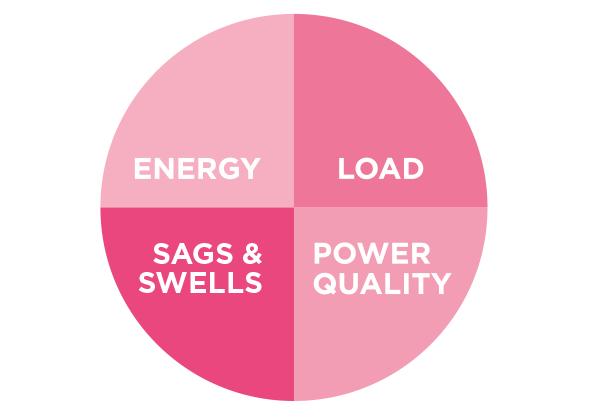The four aspects of power management
Power management is a continuous improvement process for measuring, monitoring and improving electrical energy. The purpose of power management is to save energy, reduce the chance of outages and limit maintenance costs. This is not possible by only managing consumption (kWh). The quality of voltage and current is just as important here. Harmonic pollution, resonances and voltage dips significantly increase the costs in the modern installation.
Discover what the four aspects of power management are. What can these aspects mean to reduce the consequences of poor quality of voltage and current?


1: Energy management
Save on your energy bill and reduce CO² emissions
The mandatory EED Energy audit and increasing demands from the government make continuous insight into energy flows necessary. By making energy visible, awareness and involvement in measures are increased and you have continuous insight into its effects. This also makes it possible to settle energy to sub-landlords. By visualizing the consumption from top to bottom in the installation, the energy loss, sneak users and connection errors of meters are immediately recognized.
2: Load management
Prevent overload and determine capital
Administrators of electrical installations would like to know where growth in the installation is possible without expanding the installation. Harmonic contamination, a low cos phi and unevenly loaded phases cause extra stress to the electrical installation and in particular the grid transformer.
Switching to generator mode
When switching to generator mode, it is essential to know whether there is sufficient power available to feed the connected equipment. The dynamic behavior of the load also makes it difficult to make predictions. Insight down to the millisecond is then necessary.


3: Dips and peak management
Limit the consequential costs of voltage dips and current peaks
Events such as voltage dips and current peaks can lead to failure of (parts of) the electrical installation. The downtime is shortened by timely alarms: the search for malfunctions takes less time and a solution can be searched for more quickly.
Registering dips and peaks
By registering these dips and peaks up to a resolution of 50 microseconds, the cause can be traced and it can be determined whether the voltage dip comes from the grid or has an internal cause. The data can be used to dimension an appropriate solution to absorb voltage dips.
4: Power quality management
Preventing outages, reducing maintenance costs and combating energy waste
A "healthy" voltage leads to lower maintenance costs, helps prevent outages and saves electrical energy. In addition, it provides insight and a definition of responsibilities. This is important for liability issues after an equipment failure. Voltage quality standards play an important role in this. Among other things, it determines whether equipment can be connected and whether or not equipment failure falls under warranty schemes.
Measurement concept
When integrating energy measurement systems for energy saving, it is a must to take the quality aspects of voltage and current into account and to integrate them into the measurement concept.

Power management by fortop
All aspects of power management are integrated in the fortop systems. That starts with good measurement, a good web-based monitoring environment and the products and services to improve.
At fortop you will find everything needed for a continuous improvement process to reduce energy costs, increase availability and lower maintenance costs. Ask about the possibilities!
